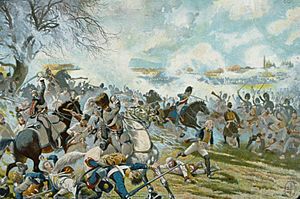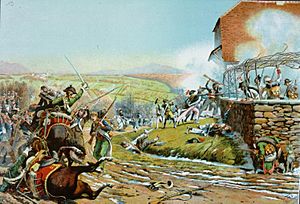Battle of Froeschwiller (1793) facts for kids
Quick facts for kids Battle of Froeschwiller (1793) |
|||||||
|---|---|---|---|---|---|---|---|
| Part of War of the First Coalition | |||||||
 Battle of Froeschwiller (painting by Frédéric Régamey, 1905) |
|||||||
|
|||||||
| Belligerents | |||||||
| Commanders and leaders | |||||||
| Units involved | |||||||
| Strength | |||||||
| 25,000 | 15,000 | ||||||
| Casualties and losses | |||||||
| 1,000 | 2,000 16 guns |
||||||
The Battle of Froeschwiller was a key battle fought from December 18 to 22, 1793. It took place near the village of Froeschwiller in France. This battle was part of the larger Wars of the French Revolution, specifically the War of the First Coalition.
In this battle, the armies of Republican France faced off against the Habsburg Austrian army. The French forces were led by Generals Lazare Hoche and Charles Pichegru. The Austrian army was commanded by Dagobert Sigmund von Wurmser.
What Happened at Froeschwiller?
The fighting began on December 18, 1793. French troops launched an attack that pushed the Austrians back a short distance. This was just the start of several days of intense fighting.
The French had a plan to attack the Austrians from different directions. General Hoche sent about 12,000 soldiers to attack the Austrian army's right side. This surprise move aimed to weaken the Austrian defenses.
The Final Push
On December 22, the French launched a very strong attack. General Hoche led five different groups of soldiers in a powerful assault. At the same time, General Pichegru's army attacked the Austrians from the south.
This combined attack was too much for the Austrian forces. They were forced to retreat all the way to Wissembourg. This victory was very important for the French. It helped them regain control of the Alsace region, which had been threatened by earlier Austrian successes.
Why Was This Battle Important?
The Battle of Froeschwiller was a significant French victory during the War of the First Coalition. It showed the growing strength and tactics of the French Republican armies.
This battle also set the stage for another important fight, the Second Battle of Wissembourg, which happened just a few days later. These battles together helped decide the fate of Alsace during the French Revolutionary Wars.


